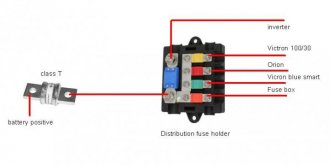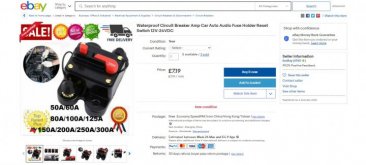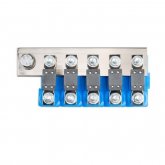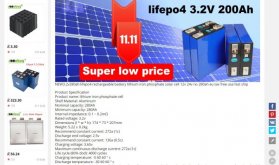rogerball0
New Member
- Joined
- Feb 18, 2021
- Messages
- 21
Hi There
With prices of prismatic cells very reasonable i decided to make the change to Lithium by purchasing 4 x 3.2v 280Ah LifePO4 batteries and a 200A Daly BMS. This is to replace my existing AGM set up. In the process i want to rework my electrics cabinet in the van and drawn a simple wiring diagram of what i want with a components list of existing parts and parts i will purchase. I'm looking for someone to play devil's advocate with my wiring design as i'm an amateur at this electrics stuff (joiner by trade)
A couple of questions:
I want to know if I can i use resettable fuses off the positive fuse holder/busbar instead of ANL fuses after the master switch? I was initially looking at the Victron Modular mega fuse holder (5 position busbar) and then thought about a simple busbar bolted into an enclosure with resettable fuses coming off of each position.
The biggest load is my 2000W inverter and the solar panels I intend fitting on the roof (either 3 x 120W panel or 1 x 360W panel so 30A draw). Other than that there's no huge current draws as all my appliances are 12v: laptop, car radio, fridge, diesel heater & water heater.
Also is it good practice to connect the Solar Charge controller directly to the battery as i have done in my diagram?
Any feedback appreciated
Cheers
Roger (UK)
*EDIT* With the Victron mega fuse holder how is the busbar made live? Is it via a ring terminal around the large bolt or do i attach an ANL fused connection from the 300A master switch to the first fuse holder position? Thanks in advance. I've also changed the format of my doodle from PDF to JPG as i realised it tries to download, now it opens in the same window. Ta Tar.
With prices of prismatic cells very reasonable i decided to make the change to Lithium by purchasing 4 x 3.2v 280Ah LifePO4 batteries and a 200A Daly BMS. This is to replace my existing AGM set up. In the process i want to rework my electrics cabinet in the van and drawn a simple wiring diagram of what i want with a components list of existing parts and parts i will purchase. I'm looking for someone to play devil's advocate with my wiring design as i'm an amateur at this electrics stuff (joiner by trade)
A couple of questions:
I want to know if I can i use resettable fuses off the positive fuse holder/busbar instead of ANL fuses after the master switch? I was initially looking at the Victron Modular mega fuse holder (5 position busbar) and then thought about a simple busbar bolted into an enclosure with resettable fuses coming off of each position.
The biggest load is my 2000W inverter and the solar panels I intend fitting on the roof (either 3 x 120W panel or 1 x 360W panel so 30A draw). Other than that there's no huge current draws as all my appliances are 12v: laptop, car radio, fridge, diesel heater & water heater.
Also is it good practice to connect the Solar Charge controller directly to the battery as i have done in my diagram?
Any feedback appreciated
Cheers
Roger (UK)
*EDIT* With the Victron mega fuse holder how is the busbar made live? Is it via a ring terminal around the large bolt or do i attach an ANL fused connection from the 300A master switch to the first fuse holder position? Thanks in advance. I've also changed the format of my doodle from PDF to JPG as i realised it tries to download, now it opens in the same window. Ta Tar.
Attachments
Last edited:








